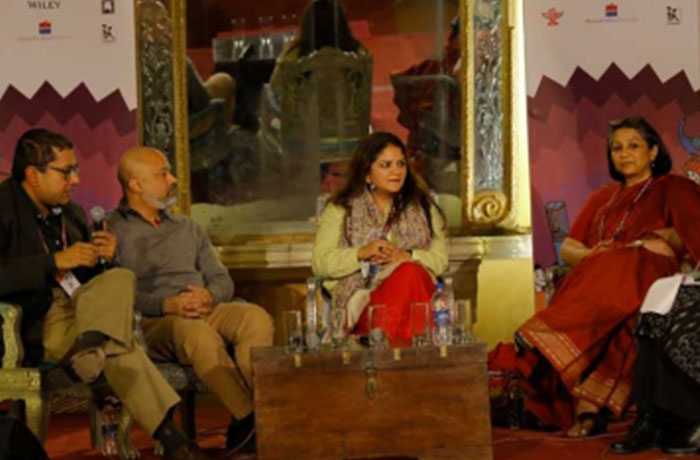
English Language Publishing: The Indian Market
Speakers: Priya Kapoor, Ranjana Sengupta, Ravi Singh and Sugata Ghosh in conversation with Preeti Gill
To describe India’s English language publishing industry as ‘thriving’ would be an understatement. In 2016, it became the second largest in the world, after the United States. As readership in the country grows by almost twenty percent annually, the panel of successful publishers from the industry deciphered some of the many opportunities and hurdles that this position presents.
Sugata Ghosh, Director of Publishing at Oxford University Press, is not convinced by the industry statistics: “I would take these numbers with a pinch of salt.” Roli Books Director Priya Kapoor agreed, explaining that there was a “chink in the system,” which kept anything other than commercial fiction from reaching audiences. As such, the numbers reflect only one aspect of the publishing market.
Kapoor identified visibility as the major problem, explaining that Roli Books aimed to publish illustrated and dynamic non-fiction books that otherwise would not make it to general bookstores. Kapoor established her own bookstore, CMYK Bookstore, in Delhi nine years ago, to try to counter this status quo, even though she was not well versed in retail. To date, CMYK Bookstore has eight successful branches around the country.
When asked whether the industry was witnessing “the death of literary fiction,” Ravi Singh, Co-founder of Speaking Tiger Publishing, echoed Kapoor’s sentiment. He claimed that literary fiction’s lesser standing in the Indian market had a lot to do with the challenges it faced from the mass of commercial fiction: “Literary fiction is not dead, its visibility has shrunk.” Singh pointed out that Speaking Tiger sold over fifteen thousand copies of Gut: The Inside Story of Our Body’s Most Under-Rated Organ, a non-fiction book, simply by making it more visible at bookstores and airports. He believes that the key was to keep publications “diverse and yet have an identity that you and the reader are proud of.”
Since the early 2000s, non-fiction has sold more than other genres in the Indian publishing industry, and since it has diversified its content, it is experiencing even more escalation in sales. Associate Publisher with Penguin, Ranjana Sengupta, revealed that Penguin published ten books on topics related to Pakistan last year, six by Pakistani writers, and they had all sold very well. While Sengupta is aware that “you can never have enough books on Partition,” she believes that readership for Pakistani writers in India goes beyond Partition, since it delves into deeper ideas of “how a society similar to ours functions.”
While there is no denying that the Indian publishing industry has grown radically in the last decade, Kapoor believes that publishers have “a responsibility to reach out to readers.” Ghosh added that that it was also up publishing houses to supplement the efforts of the government in creating readers from an early age, by fostering a “quest for knowledge,” and laying the foundations for later readership: “Unless every stakeholder contributes, nothing will happen.”
While the Indian market has an appetite for books imported from the US, the panelists believe that it is still a “one-way” street, since selling an Indian book in the US remains relatively challenging because the market is a lot less open. Sengupta observed, ‘we are a society that is trying to understand itself by reading about its issues,” but is also very open to ideas and influences from all over the world.
Commissioning Editor at Kali for Women, Preeti Gill, described India as “a repository of many kinds of knowledge,” citing her recent visit to a book club called ‘Phulkari’ in Amristar. There she observed around 150 women with no proper education, reading books as a collective. Instances such as this fill one with a sense of optimism about India’s readership: it is growing and in ways previously unheard of.






